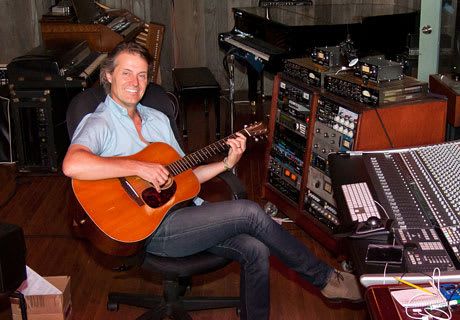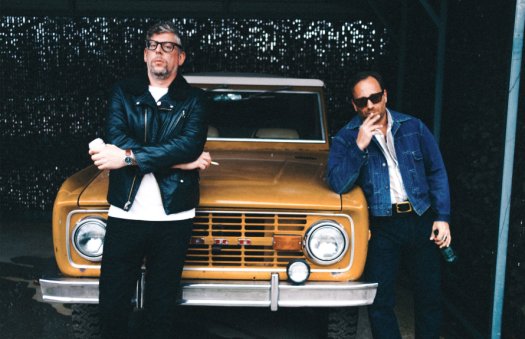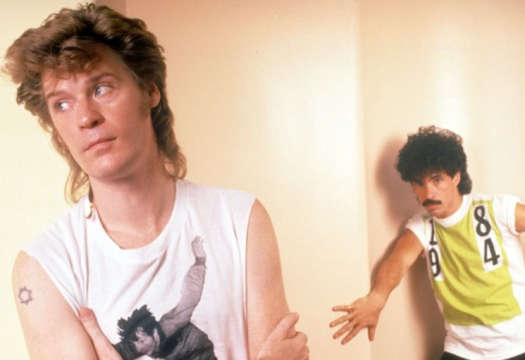Blue Rodeo's music has always been the perfect marriage of rural romanticism and urban grit, so it's only natural that those feelings are also imbued in the band's recording studio, the Woodshed. Located in the heart of Toronto's bustling Greek enclave, the Danforth, the building that also houses the band's offices was purchased in 2001 and renovated with planks from an old Ottawa Valley barn on the walls, along with Indian scarves on the ceiling. It's exactly the place where one would expect Canada's most successful roots-rock outfit to convene on a regular basis, right down to a framed and autographed print of Bobby Orr's Stanley Cup-winning swan dive goal.
All of Blue Rodeo's albums since 2002's Palace Of Gold have been made here, and the Woodshed has likewise become the preferred recording space for others within the BR circle, such as the Sadies, Cuff the Duke, and more recently, One Hundred Dollars. While half of Blue Rodeo's singer/songwriter partnership, Greg Keelor, maintains a studio on his farm near Peterborough ON, the Woodshed is the personal workshop for the group's other co-founder Jim Cuddy. It was here that Cuddy wrote and recorded the 14 tracks on his just-released third solo album, Skyscraper Soul, and he says that having an open concept environment like the Woodshed in which to work on new music every day has been essential in feeding his creative drive.
"I never want to be in a compromising position where I could be holding back a Blue Rodeo song for a solo album," Cuddy says. "For me, it comes down to having the time to range out on my own. I help make up the band's schedule, and I knew that we'd have downtime this fall so I'd be able to put out a solo album. I set aside two blocks of time last winter to make it, and for the writing, I'd come in every day at 10 a.m. and just work. Actually, that's what I do most days when we're not on tour, which is one of the great benefits of having this space."
The Woodshed was never intended to be just a clubhouse for Blue Rodeo though, Cuddy adds. He says that after the band made its 2000 album The Days In Between at Daniel Lanois's Kingsway Studio in New Orleans, they determined to build their own open concept studio back home that could offer that same experience at a reasonable rate to artists they knew. "We don't have many fond memories of recording studios in Toronto," Cuddy admits. "It's not a good feeling when you do a take and you see a couple of guys in the control room talking to each other and you have no idea what they're saying. We'd had some great success setting up our own temporary spaces, but Daniel's studio in New Orleans showed us that we could have something more permanent and involve our community of musical friends, the same way he had done down there."
The Woodshed's casual atmosphere has particularly come in handy on Cuddy's solo projects, since he and his band ― comprised of guitarist Colin Cripps, fiddler Anne Lindsay, keyboardist Steve O'Connor and drummer Joel Anderson, along with Blue Rodeo bassist Bazil Donovan ― don't get to play together regularly. It also allowed Cuddy to explore some new territory in terms of arrangements and instrumentation on Skyscraper Soul.
"This album grew out of the music I wrote for a short film my wife [Rena Polley] did called Four Sisters," Cuddy explains. "The first song to come from that was 'Water's Running High,' on which Steve played organ and my son played piano. Splitting those parts up is a big thing in my world, and on top of that I wanted a trumpet player on it. We did two live takes and it was perfect, and that approach of sort of getting me out of my comfort zone became the template for the rest of the album."
Cuddy adds, in regards to the studio itself, "I think this place has become what we envisioned it would be, and it's also evolved concurrent with how recording has become more home-based and much less expensive. I'm always happy when people want this space because they believe it has a particular sound or vibe. All we hoped to do was create something with character and make it accessible to a broad range of friends and musicians, and I believe that's what we've done."
Still, no matter how much the band hoped the Woodshed could help recreate the rustic heart of its biggest selling album, 1993's Five Days In July, the reality of life in the big city could not be avoided. "The subway runs right underneath the building," Cuddy says with a laugh. "The first time we were ready to record in here, we were so excited. Then we heard this rumble on the playback. Now we've just learned to work around the peak hours."
All of Blue Rodeo's albums since 2002's Palace Of Gold have been made here, and the Woodshed has likewise become the preferred recording space for others within the BR circle, such as the Sadies, Cuff the Duke, and more recently, One Hundred Dollars. While half of Blue Rodeo's singer/songwriter partnership, Greg Keelor, maintains a studio on his farm near Peterborough ON, the Woodshed is the personal workshop for the group's other co-founder Jim Cuddy. It was here that Cuddy wrote and recorded the 14 tracks on his just-released third solo album, Skyscraper Soul, and he says that having an open concept environment like the Woodshed in which to work on new music every day has been essential in feeding his creative drive.
"I never want to be in a compromising position where I could be holding back a Blue Rodeo song for a solo album," Cuddy says. "For me, it comes down to having the time to range out on my own. I help make up the band's schedule, and I knew that we'd have downtime this fall so I'd be able to put out a solo album. I set aside two blocks of time last winter to make it, and for the writing, I'd come in every day at 10 a.m. and just work. Actually, that's what I do most days when we're not on tour, which is one of the great benefits of having this space."
The Woodshed was never intended to be just a clubhouse for Blue Rodeo though, Cuddy adds. He says that after the band made its 2000 album The Days In Between at Daniel Lanois's Kingsway Studio in New Orleans, they determined to build their own open concept studio back home that could offer that same experience at a reasonable rate to artists they knew. "We don't have many fond memories of recording studios in Toronto," Cuddy admits. "It's not a good feeling when you do a take and you see a couple of guys in the control room talking to each other and you have no idea what they're saying. We'd had some great success setting up our own temporary spaces, but Daniel's studio in New Orleans showed us that we could have something more permanent and involve our community of musical friends, the same way he had done down there."
The Woodshed's casual atmosphere has particularly come in handy on Cuddy's solo projects, since he and his band ― comprised of guitarist Colin Cripps, fiddler Anne Lindsay, keyboardist Steve O'Connor and drummer Joel Anderson, along with Blue Rodeo bassist Bazil Donovan ― don't get to play together regularly. It also allowed Cuddy to explore some new territory in terms of arrangements and instrumentation on Skyscraper Soul.
"This album grew out of the music I wrote for a short film my wife [Rena Polley] did called Four Sisters," Cuddy explains. "The first song to come from that was 'Water's Running High,' on which Steve played organ and my son played piano. Splitting those parts up is a big thing in my world, and on top of that I wanted a trumpet player on it. We did two live takes and it was perfect, and that approach of sort of getting me out of my comfort zone became the template for the rest of the album."
Cuddy adds, in regards to the studio itself, "I think this place has become what we envisioned it would be, and it's also evolved concurrent with how recording has become more home-based and much less expensive. I'm always happy when people want this space because they believe it has a particular sound or vibe. All we hoped to do was create something with character and make it accessible to a broad range of friends and musicians, and I believe that's what we've done."
Still, no matter how much the band hoped the Woodshed could help recreate the rustic heart of its biggest selling album, 1993's Five Days In July, the reality of life in the big city could not be avoided. "The subway runs right underneath the building," Cuddy says with a laugh. "The first time we were ready to record in here, we were so excited. Then we heard this rumble on the playback. Now we've just learned to work around the peak hours."




